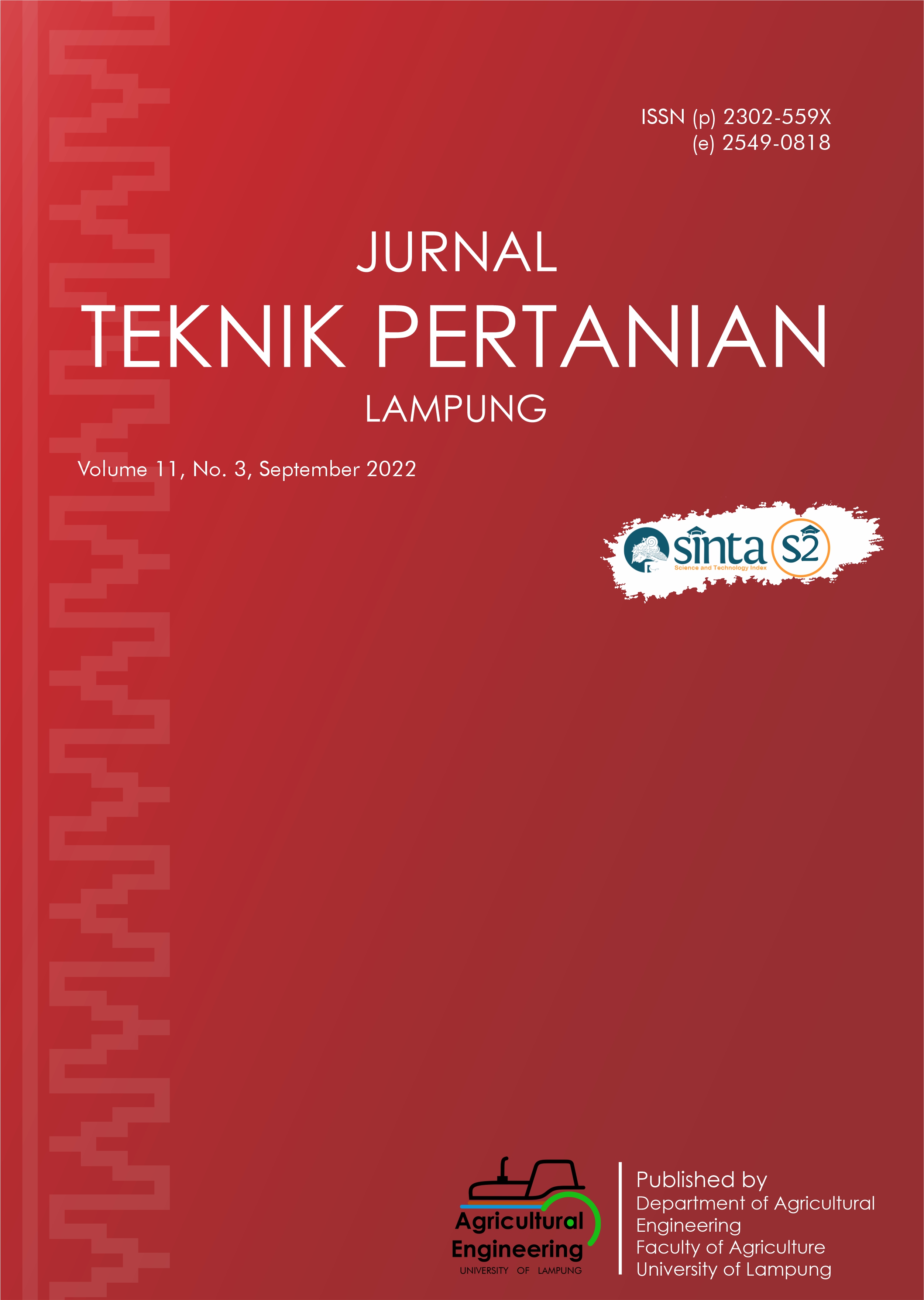Performance Test of Cassava Cutting Machine Type of Double Block Cutter
DOI:
https://doi.org/10.23960/jtep-l.v11i3.494-504Abstract
Preparation of cassava seeds using a machete or hand saw takes a long time, the results are not uniform, and there is a potential for damage to cassava seedlings. The double block cutter type cassava stem cutting machine has been designed to produce high capacity and good quality cassava seeds. This study aims to test the performance of the cassava stem cutting machine with the double block cutter type. Performance tests include measuring machine working capacity, fuel consumption, seed uniformity, and planting test. The cutting test was carried out using 3 varieties of cassava seedlings. The machine works at a rotational speed of 3800 rpm and the test was carried out with various feeding loads, namely 3 rods, 4 rods, and 5 rods with. Each test was repeated 3 times. Cassava stem cutting machine (Petokong) is suitable for producing cassava stems with an average working capacity of 16275 seeds/hour. The results of the Anova test showed that the number of baits and varieties of cassava seeds and their interaction had a significant effect on the working capacity of the Petokong machine. Variations in fuel consumption are thought to be influenced by the variety of cassava stem used, which is influenced by the stem diameter of each variety. The Petokong machine is far superior to manual cutting using a machete or saw which can only produce 815 and 3005 seeds/hour per hour. The average fuel consumption is 1.82 liters per hour. Seed uniformity is about 98% and seedling damage can be minimized to 2%. The seeds produced by the Petokong machine can grow well, which is indicated by the appearance of shoots and an even distribution of roots.
Keywords: Cassava seeds, Cassava stem cutter, Double block cutter, Petokong
References
Amarullah, Indradewa, D., Yudono, P., Hendro, B., & Sunarminto. (2016). Correlation of growth parameters with yield of two cassava varieties. Jurnal Ilmu Pertanian (Agricultural Science), 1(3), 100-104. https://doi.org/10.22146/ipas.10706
Amien, E.R., Asmara, S., Kurnia, F., & Suharyatun, S. (2021). Studi analisis kelayakan ekonomi mesin perajang batang singkong (Rabakong) tipe TEP 2. Open Science and Technology, 1(1), 105-113.
BPS (Badan Pusat Statistik). (2017). Produksi Ubi Kayu Menurut Provinsi (ton) 1993-2015. https://www.bps.go.id/linkTableDinamis/view/id/880 (visited 12 July 2022).
Esaputra, G.B.W., Kusuma, I.G.B.W., & Suryawan, A.A.A. (2016). Pengaruh penggunaan bahan bakar liquefied gas for vehicle (LGV) terhadap konsumsi bahan bakar, SFC, dan emisi gas buang pada mobil. Jurnal METTEK, 2(2), 83-92.
Hasanudin, U., Kustyawati, M.E., Iryani, D.A., Haryanto, A, & Triyono, S. (2019). Estimation of energy and organic fertilizer generation from small scale tapioca industrial waste. IOP Conference: Earth and Environmental Science, 230, 012084. https://doi.org/10.1088/1755-1315/230/1/012084
Jyoti, B., Karthirvel, K., Durairaj, CD. (2018). Effect of blade angles and thickness on specific cutting energy and cutting index of cassva stem. Journal of AgriSearch, 5(2), 126-129.
Kurniawan, A. (2019). Rancang Bangun dan Uji Kinerja Mesin Pemotong Bibit Singkong (Petokong) Double Block Cutter. [Undergraduate Thesis]. Universitas Lampung, Bandar Lampung.
Legese, H., Gobeze, L., Shegro, A., Geleta, N. (2011). Impact of planting position and planting material on root yield of cassava (Manihot esculenta Crantz). Journal of Agricultural Science and Technology, 5(4), 448-454.
Nugeraheni, I.K., & Pratama, M.M.A. (2018). Pengukuran penggunaan bahan bakar biofuel (premium dan bioetanol) terhadap kinerja mesin bensin 4 Tak. Jurnal Elemen, 5(1), 1-6
Nahar, E.N., & Tan, S.L. (2012). Cassava mini-cuttings as a source of planting material. J. Trop. Agric and Fd. Sc., 40(1), 1-6.
Pardales, J.R., Banoc, D.M., Yamauchi, A., Iijima, M., & Kono, Y. (1999). Root dystem development of cassava and sweetpotato during early growth stage as affected by high root zone temperature. Plant Prod. Sci., 2(4), 247-251.
Remison, S.U., Omorodion, E., Eifedyi, E.K. (2015). A re-examination of the effects of length of stem cuttings on the growth and yield of cassava (Manihot esculenta Cranyz). Nigerian Annals of Natural Sciences, 15(1), 9-13.
Siswati, L., Ardie, S.W., & Khumaida, N. (2019). Pertumbuhan dan perkembangan ubi kayu genotipe lokal Manggu pada panjang setek batang yang berbeda. J. Agron. Indonesia, 47(3), 262-267.
Wei, M., Andersson, R., Xie, G., Salehi, S., Bostrom, D., Xiong, S. (2018). Properties of cassava stem starch being a new starch resource. Starch-Starke, 70(5-6), 1700125. https://doi.org/10.1002/star.201700125
Widayat, Hadiyanto, Satriadi, H., Suzery, M., Budianto, I.A. (2019). Peningkatan produksi mocaf dengan rancang bangun alat pemotong. Jurnal Ilmu Lingkungan, 17(3), 515-521.
Yusuf, A., Sugandi, W.K., & Zaida. (2020). Rancang bangun mesin pengupas talas semir. Jurnal Teknik Pertanian Lampung, 9(1), 19-27.
Downloads
Published
Issue
Section
License
- Authors who publish with this journal agree to the following terms:
- Authors retain copyright and grant the journal right of first publication with the work simultaneously licensed under a Creative Commons Attribution-ShareAlike 4.0 International Lice that allows others to share the work with an acknowledgement of the work's authorship and initial publication in this journal.
- Authors are able to enter into separate, additional contractual arrangements for the non-exclusive distribution of the journal's published version of the work (e.g., post it to an institutional repository or publish it in a book), with an acknowledgement of its initial publication in this journal.
- Authors are permitted and encouraged to post their work online (e.g., in institutional repositories or on their website) prior to and during the submission process, as it can lead to productive exchanges, as well as earlier and greater citation of published work (See The Effect of Open Access).
Jurnal Teknik Pertanian Lampung

JTEPL is licensed under a Creative Commons Attribution-ShareAlike 4.0 International License.

